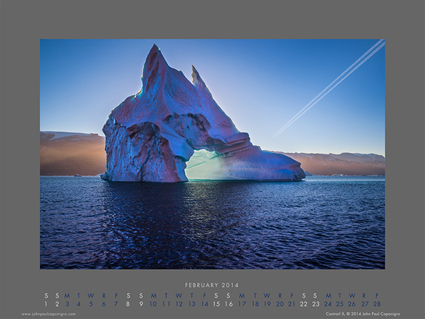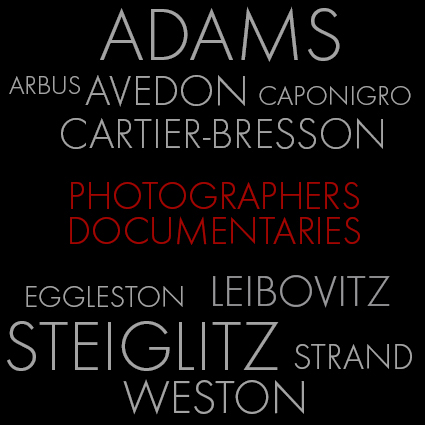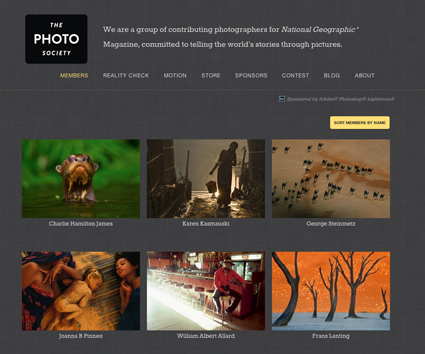Enjoy My Free February Desktop Calendar

This month’s desktop calendar features an image from Rodefiord, Greenland.
Download it here now.

This month’s desktop calendar features an image from Rodefiord, Greenland.
Download it here now.

It’s insightful to learn about and from the photographers who make the classic photographs.
Here’s a collection of videos on photographers that I’ve enjoyed most.
You’ll find them inspiring!
Where do I recommend you start? With the classics – in red.
Sam Abell | View
Ansel Adams | View 1 | View 2 | View 3
Robert Adams | View
Diane Arbus| View
Richard Avedon | View
James Balog | View 1 | View 2 | View 3
Ruth Bernhard | View
Yann Arthus-Bertrand | View
Phil Borges | View
Bill Brandt | View
Edward Burtinsky | View
John Paul Caponigro | View
Paul Caponigro | View
Harry Callahan | View
Henri Cartier-Bresson | View 1 | View 2 | View 3 | View 4 | View 5
Chuck Close| View
Anton Corbijn | View
Gregory Crewdson| View
Bruce Davidson | View
William Eggleston | View 1 | View 2
Alfred Eisendstaedt | View
Walker Evans | View
Andreas Feininger | View
Robert Frank | View
Ralph Gibson | View
Laura Gilpin | View
Nan Goldin | View
Emmet Gowin | View
Gregory Heisler | View 1 | View 2
David Hockney | View 1 | View 2
Chris James | Coming Soon
Bill Jay | View
Chris Jordan | View
Michael Kenna | View
Sean Kernan | View
Andre Kertesz | View
David LaChapelle | View
Frans Lanting | View
Jacques-Henri Lartigue | View
Annie Leibovitz | View 1 | View 2
Jay Maisel | View
Sally Mann | View 1 | View 2 | View 3
Arthur Meyerson | View
Duane Michals | View 1 | View 2
Mary Ellen Mark | View
Steve McCurry | View
Joe McNally | View
Joel Meyerowitz | View
Richard Misrach | View
Tina Modotti | View
Sarah Moon | View
Edward Muybridge | View
James Nachtwey | View
Arnold Newman | View
Helmut Newton | View
Gordon Parks| View
Martin Parr | View
Eliot Porter | View
Chris Rainier | Coming
Eugene Richards | View
Sebastiao Salgado | View 1 | View 2
John Sexton | View 1 | View 2
Cindy Sherman | View
Stephen Shore | View
Aaron Siskind | View
Eugene Smith | View
Rick Smolan | View
Fredrick Sommer | View
Edward Steichen | View
Alfred Stieglitz | View
Paul Strand | View
Hiroshi Sugimoto | View
Joyce Tenneson | View
George Tice | View
Pete Turner | View
Jerry Uelsmann | View
Nick Veasey | View
Jeff Wall | View
Andy Warhol | View
Weegee | View
Edward Weston | View
Kim Weston | View
Garry Winogrand | View
Dan Winters | View
Huntington Witherill | View 1 | View 2
Art Wolfe | View
–
View new additions to this collection here.
Read The Essential Collection Of Photographer’s Quotes here.
Read my conversations Photographers On Photography here.
Here’s a selection of my favorite quotes by photographer Robert Frank.
“The eye should learn to listen before it looks.” ― Robert Frank
“When people look at my pictures I want them to feel the way they do when they want to read a line of a poem twice.”
― Robert Frank
“A message picture is something that’s simply too clear.” – Robert Frank
“To produce an authentic contemporary document, the visual impact should be such as will nullify explanation.” – Robert Frank
“Black and white are the colors of photography. To me they symbolize the alternatives of hope and despair to which mankind is forever subjected.” – Robert Frank
“I am always looking outside, trying to say something that is true. But maybe nothing is really true. Except what’s out there. And what’s out there is constantly changing.”
― Robert Frank
“There is one thing the photograph must contain, the humanity of the moment. This kind of photography is realism. But realism is not enough – there has to be vision, and the two together can make a good photograph.” – Robert Frank
“I have been frequently accused of deliberately twisting subject matter to my point of view. Opinion often consists of a kind of criticism. But criticism can come out of love.” – Robert Frank
“I always say that I don’t want to be sentimental, that the photographs shouldn’t be sentimental, and yet, I am conscious of my sentimentality.” – Robert Frank
“It is always the instantaneous reaction to oneself that produces a photograph.” – Robert Frank
“My photographs are not planned or composed in advance, and I do not anticipate that the onlooker will share my viewpoint. However, I feel that if my photograph leaves an image on his mind, something has been accomplished.” – Robert Frank
“Above all, life for a photographer cannot be a matter of indifference” ― Robert Frank
Read more Photographer’s Quotes here.
Learn about the life and influence of photographer Robert Frank in this video.
Find out about his seminal work The Americans in this video.
View more Videos On Photographers here.
Read conversations with photographers here.
Marshall Poe offers a short and insightful rumination on changing practices and perceptions in war photography in this chapter of his video series History Through Images.
View more Photography Videos here.
“Julieanne Kost, Adobe Principal Evangelist Photoshop and Lightroom, demonstrates Linked Smart Objects in Photoshop CC. Discover when to embed and when to link Smart Objects as well as learn how to update modified content, resolve missing files and filter based on Smart Object attributes.”
View more Photoshop Videos here.
Learn more in my Digital Photography and Digital Printing Workshops.

Check out The Photo Society. You’ll get lost in fantastic photography by top photographers. Who are they?
“We are a group of contributing photographers for National Geographic Magazine, committed to telling the world’s stories through pictures.”
“Explaining the diversity of this group is the easiest way to answer the question, “How do I become a National Geographic photographer?” I usually answer this question by saying: ‘It is not easy or glamorous (see Reality Check). And this is not where you begin your career. You are competing with world-class documentary photographers and within that genre there are men and women who are the absolute best at their specialty. There are a number of specialists — underwater photographers with different skills — one works in very deep water; a couple photograph at all depths and temperatures; one dives in caves, another holds his breath under whales; and then there is a guy who just works in puddles. One photographer travels all over the world to strap a big fan on his back to shoot aerials. There is a bug guy, an archeology specialist, and a number of folks that photograph critters. There are climbers, conflict photographers, portrait photographers and landscape specialists.’ Then I usually end with how amazed I am that I can survive in this crowd as a generalist… in such esteemed company.” – Randy Olson
Find out who they are here.
Visit The Photo Society here.
Plus, find out the top hazards of being a National Geographic Photographer.
“Julieanne Kost, Adobe Principal Evangelist Photoshop and Lightroom, walks through the new Perspective Warp feature in Photoshop CC. Learn how to create quads, adjust the layout, and distort the perspective of an image.”
View more Photoshop Videos here.
Here’s a selection of quotes by photographer David LaChapelle.
“I believe in a visual language that should be as strong as the written word.” – David LaChapelle
“I was always painting when I was a kid. But then when I handled a camera when I was 17, that was it for me. I loved photography. I would work 4 or 5 hours a day. It was like a calling.” – David LaChapelle
“I went to art high school and thought I’d be a painter. Unfortunately I didn’t finish high school, but that’s always been part of my work.” – David LaChapelle
“I’m a photographer, period. I love photography, the immediacy of it. I like the craft, the idea of saying ‘I’m a photographer.” – David LaChapelle
“People say photographs don’t lie, mine do.” – David LaChapelle
“I didn’t see any difference between being a photographer or being an artist. I didn’t make those boundaries. If someone wants to think it’s art, that’s great, but I’ll let history decide.” – David LaChapelle
“Then I got this idea in my head that magazines were like a gallery and if you got your magazine page ripped out and someone stuck it on their refrigerator, then that was a museum – someone’s private museum.” – David LaChapelle
“You just do what you love, and then a style happens later on.” – David LaChapelle
“I was working in this very bombastic style. I didn’t really know about style. I didn’t think about it: I did what I was interested in, what I was attracted to, what I was drawn to. I was drawn to color, and I was drawn to humor, and I was drawn to sexuality and spontaneity. It was all really intuitive. I never really thought, “Well this is the style…” – David LaChapelle
“I wanted it to provide an escape route, I wanted to make pictures that were fantastic and took you into another world, one that was brighter. I started off with this idea.” – David LaChapelle
“For me, it’s easier to like more things than to dislike them; I’m not a critic in that sense. I find it easier to like more, to be more open and enjoy more things, which has given me more opportunities.” – David LaChapelle
“I never want people to be repulsed with my pictures; I always want to attract people.” – David LaChapelle
“Just as Renaissance artists provided narratives for the era they lived in, so do I. I’m always looking beyond the surface. I’ve done that ever since I first picked up a camera.” – David LaChapelle
“In the fashion world, I was always an outsider, but I made people look good, so I had a career.” – David LaChapelle
“My idea was that if I took a picture of somebody and years later, or whenever, they would die and if someone wanted to know who this person was, they could take one of these pictures and it would tell who the person was.” – David LaChapelle
“I have this idea that you can use glamour and still have it represent something that matters.” – David LaChapelle
“The tools I learned photographing celebrities, now I want to use them to sell ideas.” – David LaChapelle
“The adornment of the body is a human need. I don’t see anything superficial about it unless your life becomes very materialistic.” – David LaChapelle
“I like thinking about the fragility of the human flesh and our bodies – our decay and eventual death.” – David LaChapelle
“It’s much harder to work for yourself, by yourself, than to create work for a gallery, because there are no limits and you can do anything you want. It’s always easier when you have a parameter, when you have a limit. You can work within the limit and push it and walk the line, but when you’re given absolutely no limits, it’s harder. You must really think. It’s more challenging.” – David LaChapelle
“I’ve never wanted to be part of an inner circle of any scene. I’ve always been an outsider looking to question and subvert.” – David LaChapelle
“Success to me is being a good person, treating people well.” – David LaChapelle
Visit David LaChapelle’s website here.
View 12 Great Photographs By David La Chapelle.
View video about David LaChapelle here.
Read more Photographer’s Quotes here.

